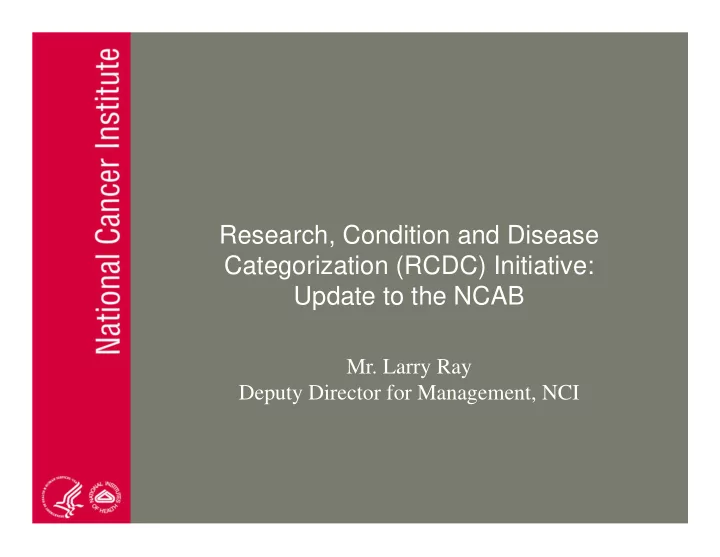

Research, Condition and Disease Categorization (RCDC) Initiative: Update to the NCAB Mr. Larry Ray Deputy Director for Management, NCI
Today’s Presentation • Introductions – Lisa Krueger, Research Analysis and Evaluation Branch, Division of Extramural Activities, NCI Point of Contact for RCDC • Overview of Scientific Coding • Update on RCDC • Q & A
What is Scientific Coding? Science-based Budget Information • Research projects are analyzed and classified for scientific content. • Analysis of the distribution of funds across research areas serve as a basis for budget projections. • Scientific coding is necessary in order to answer inquiries on the scientific and budgetary aspects of NIH and NCI-funded research.
Scientific Coding at the NCI • As leader of the National Cancer Program, NCI is authorized and mandated to collect and disseminate cancer research data • To meet this mandate, NCI developed and refined a coding approach that has been employed for over 25 years to report its research investment including basic research and infrastructure – Analyze the entire project – Prorating dollars based on percent disease relevance
Scientific Coding Across NIH • Scientific coding at NIH has been varied in its approach and its breadth and depth • The NIH Reform Act of 2006 requires that NIH establish an electronic system to uniformly code research grants and activities – NIH annually reports to Congress how much we spend on ~360 research, condition and disease (RCD) categories – Currently 14 cancer categories are reported annually
NIH Automated Coding: The Research, Condition and Disease Categorization (RCDC) Initiative • RCDC will automate this process with the following goals: – Create Trans-NIH definitions (or Fingerprints) for each of the RCD categories – Eliminate the differences in 27 IC coding methodologies – Improve transparency by providing project listings for each category • RCDC will: – Analyze the project title, abstract, and specific aims – Adhere to “all-or-nothing” budget rule
NCI Participation in the Development and Implementation of the RCDC Initiative
NCI Participation in Development and Implementation of the RCDC Initiative NCI involvement in the following RCDC Working Groups • Fingerprint Working Group • Knowledge Management Governance Group • Technical Advisory Group • Budget Algorithm Group • Subprojects Working Group • Intramural Working Group • Contracts Working Group • Point of Contact • OPASI Working Group • RCDC Advisory Group • Power Users Group • Data Analysis Working Group • RCDC Fingerprint Dashboard Requirements Group • Engagement Working Group
NCI Participation in Development and Implementation of the RCDC Initiative • Fingerprint Development – Contributed the NCI Thesaurus – 89 NCI Subject Matter Experts have been recruited to participate. – Additional NCI staff who participate in RCDC Working Groups. – NCI participated in 91 RCD categories, involving over 160 Fingerprint Sessions – NCI evaluated the categorization of 14,000 grants in 131 validity tests, generated by RCDC using the FY2005 dataset and over 20,000 grants using the FY2006 dataset • Information Dissemination / Training ― NCI Intranet Web site ― NCI Town Hall for RCDC ― SharePoint site for workspace/training/information dissemination ― NCI Sponsored Online 1688 Module Training
The RCDC Timeline • The goal is to finish all Fingerprints on 11-11-2008 in order that RCDC can create the FY2008 NIH Report to Congress • RCDC will also post FY2007 data at that time so that the public can compare FY2007 category funding from the current NIH coding process with the new RCDC categorization process (referred to as the FY07 ‘Crosswalk’) • The FY07 Crosswalk data was made available to the ICs in April, 2008
Next Steps • NCI is committed to working with NIH to harmonize the coding approaches to yield a more accurate, transparent reporting system overall • NCI is actively working with OPASI to anticipate questions and other related issues in the cancer community and Congress – Communications are being developed to address questions that may arise about the new technology – Continue to work with RCDC to ensure accuracy in reporting
Recommend
More recommend